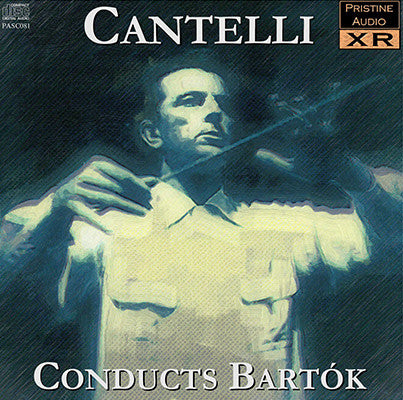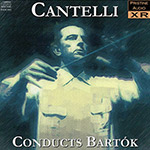
This album is included in the following sets:
This set contains the following albums:
- Producer's Note
- Full Track Listing
- Cover Art
Cantelli Conducts Bartók
The condition of the earlier recording, the Concerto for Orchestra, was not so good. Its frequency range was far more limited and the discs from which it had been transferred were in places quite badly damaged. I have spent many hours restoring (and in places, virtually rebuilding) the audio on this recording with, I believe, some success. However, there are limits to what is possible, and some mild unevenness in sound quality may be noticed at times.
BARTÓK Music for Strings, Percussion and Celesta
BARTÓK Concerto for Orchestra
NBC Symphony Orchestra
conducted by Guido Cantelli
Music
for Strings, Percussion and Celesta played by the Boston Symphony
Orchestra, taken from a WGBH-FM Boston broadcast, recorded 27th March,
1954.
Concerto for Orchestra played by the NBC Symphony Orchestra, taken from an NBC radio broadcast, recorded 29th January 1949.
Pristine Audio XR remastering by Andrew Rose, June-July 2007
Duration 68:36
MusicWeb International Review
It’s the very reference model of the works in sound so close to real that it’s truly amazing. Simply essential.
In
these days of slick CDs sounding as if they were recorded
nowhere at all it takes a lot to get a cynical old beast
like me excited. However this Pristine Audio Bartók release
was thrilling from the first hearing.
Okay,
Guido Cantelli (1920-1956) was so very special and his death
in a plane crash in Paris robbed the world of a genius but
he could be a bit wayward now and then. I cite his Britten ‘Sinfonia
da Requiem’ which he excavates with his orchestral instincts
but at the expense of what Britten actually wrote. It is
in fact the only serious lapse I can recall. Damned exciting
though and Britten agreed.
If
you haven’t heard his Brahms, Schumann and Tchaikovsky you
haven’t lived. Cantelli was the assoluto of the orchestra
with a commanding ability to draw evident pleasure from musicians
from many nations. His accuracy of tempo was greatly admired
by men far older than he.
The Music
for Strings, Percussion and Celesta (1937) is
a very tough work to deliver successfully. Cantelli’s
1954 recording reminded me of the first time I heard
Pierre Boulez do it as the new conductor of the BBCSO
in his first Prom season in the Royal Albert Hall, London.
Boulez eschews the baton and the stunning sound was as
if his fingers were pulling invisible strings to all
players; the enormous audience was silent. In all probability
there was no greater silence than in this Cantelli live
performance of 1954. That thrill of Boulez was brought
back by this astonishing release. If anything, Cantelli
is a nose ahead because Boulez never replicated that
live thrill on record. We are fortunate that Cantelli
was recorded live on 27 March 1954 . I wonder if the
WGBH-FM Boston engineers on that night knew that they
were broadcasting perfection. It seems likely that members
of the Boston Symphony Orchestra knew that something
special was happening.
What
is special is that this complex work with dynamic extremes
opens with the strings muted in violins and violas then goes
to the rest of the strings at a measured pace; shades of
Vaughan Williams 6th Epilogue of later years.
The added strings, under masterly discipline, build up the
keening dynamics to a climactic point. It is as if the entry
of the timpani is required to return the strings to their
wandering quest with a little goodbye from the celesta.
Cantelli
takes the second movement Allegro at score pace with
just a few valid Magyar syncopation strokes. He makes it
fun after the rather pessimistic opening movement and there’s
brilliant attention to pizzicato to set against the celesta
interventions. It all makes sense with celebration coming
like the resolution of a lovers’ spat.
The Adagio third
movement is slightly quicker than Boulez and Solti on record
but my “reference” favourite old EMI LP with Gyorgy Lehel
conducting Hungarian musicians is just a fraction over Cantelli’s
6:12.
That
touch of urgency after the slow opening of wood blocks and
timps followed by lower strings is a masterstroke. Cantelli’s
pace makes sense when the sliding string passage against
celesta and pedal timp moves to resolution and development. Most
conductors miss the point that if Bartók had wanted a peak
in the violas he would have written it. Here we find Cantelli
getting the best of the lower strings and varied percussion
(including piano) at a slower pace than even Lehel. The tensions
of stretched harmonies flow out uniquely in my experience.
Cantelli even keeps the stronger string dynamics without
vibrato. The result is to weld this strange music to the
musical agenda of the whole work if one listens hard.
The
final movement, Allegro molto sounds as if a Magyar
was conducting but the score is clear. The difference between
Lehel and Cantelli is a cigarette paper except for phrasing
points when the fun music needs to romp. Cantelli is maybe
a bit less abandoned than Lehel but remarkable nonetheless.
The
biggest danger with this work is that the movements can seem
disparate. I feel that about the Solti (Decca), which is
probably the most familiar. Boulez knits it well enough in
his recordings but he was better live. Lehel’s authenticity
is frankly outclassed by Cantelli’s depth of understanding
of the actual music.
The Concerto
for Orchestra (1943) is from Bartók’s very few
American years when he left Hungary to avoid Nazi oppression.
That period saw his last quartet - one of profound sadness
- and a few interesting works. However for him there
was no red carpet treatment and he was already in poor
health with the leukaemia which caused his death in 1945.
Koussevitsky
commissioned the Concerto for the Boston SO but the Cantelli
version is with the NBCSO and was recorded for/from radio
on 29 January 1949.
The
invention of a true ‘concerto for orchestra’ in five movements
was brilliant enough in itself. In it Bartók gave value aplenty
by looking back to Europe and his beloved Hungary with unusually
generous orchestration. Even so, there was more. Bartók never
learnt English - even the American version - but was well
aware of events during a terrible war. As well as retaining
his sense of humour sufficient to satirise Shostakovich’s ‘Leningrad
Symphony’ in the fourth movement he knew that his fellow
composer was under a dictator just the same as his own country
was by invasion.
To
my mind Cantelli in 1949 captured the essence of the Concerto as
a supreme musician better than Koussevitsky, Reiner,
Solti and even modern conductors such as Rahbari on Naxos.
That said it’s still difficult to say precisely how he did
this; only listening makes the point. The faithfulness, discipline
and genius of Cantelli is mercifully retained through this
recording but just how Pristine Audio’s engineers dig out
the actual sonics as they do is a mystery to me.
Cantelli’s
analytical style with innate musicality makes sense of this
as a concerto for an orchestra. Contrast this with a performance
that communicates the work as ‘a piece for orchestra in five
movements’ as it sometimes seems to be on disc. Cantelli
spots exactly what Bartók intended in emphasis of orchestral
sections. So did Reiner with the Chicago Symphony Orchestra
for RCA. The sound is better in this Pristine Audio release
of tapes taken down before stereo.
Now
the gripes. Only one of them is to do with Cantelli’s performance.
At the opening of the final movement there is a 12 note brass
fanfare but Cantelli delays the last one for longer than
the score shows; it sounds a bit odd – especially for Cantelli.
If this is due to editing I trust that Pristine Audio’s genius
engineer Andrew Rose will let us know. With the remainder
of that movement simply so perfect I am probably being picky.
However with the rest of this performance so perfect a ‘glitch’ like
this stands out.
My
other gripe is that the review copy I received was in a little
wallet with front and back sheets usually to be found in
a jewel case. There’s no insert and no information about
the venues of the recordings. We can assume that the Boston
Symphony Orchestra played in Boston Symphony Hall but I have
no idea about where the NBC Symphony Orchestra was recorded.
When a release is as important as this one the more information
we have the better (Pristine offers recordings as downloads.
This CDR was specially supplied for review so did not carry
full documentation. Downloads are available from
the
Pristine
website - Ed.).
Without
reservation I recommend this issue. It’s the closest to analogue
sound by a genius that you will hear. That said, a good outboard
DAC is essential, avoid headphones and use very good speakers.
Then you will hear Bartók in extremely important works as
near to reality under a conductor of genius.
If
you like Bartók’s music or are just getting to know it then
you must have this CD. It’s the very reference model
of the works in sound so close to real that it’s truly amazing. Simply
essential.
Stephen Hall

